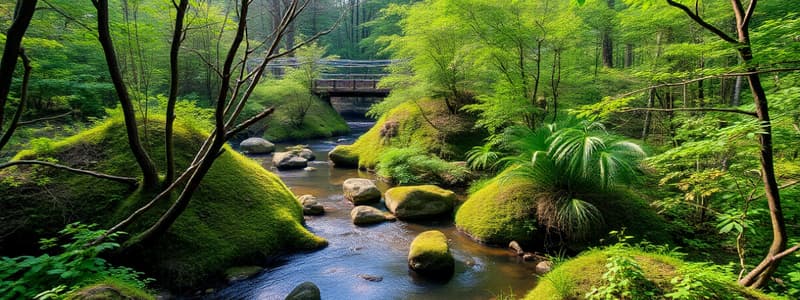Podcast
Questions and Answers
What is the primary factor that species richness tends to decline with?
What is the primary factor that species richness tends to decline with?
- Geographic location (correct)
- Soil diversity
- Proximity to water sources
- Altitude
Which statement correctly describes keystone species?
Which statement correctly describes keystone species?
- Elimination can greatly affect the structure of the ecosystem. (correct)
- Their introduction always leads to an increase in biodiversity.
- They have no significant impact on their ecosystem.
- They are the most abundant species in any ecosystem.
What percentage of all amphibian species are facing extinction?
What percentage of all amphibian species are facing extinction?
- 33% (correct)
- 50%
- 10%
- 25%
Which of the following is NOT a factor in the decline of amphibian populations?
Which of the following is NOT a factor in the decline of amphibian populations?
What constitutes a biome?
What constitutes a biome?
Which range of average annual precipitation defines an ecosystem with high species diversity?
Which range of average annual precipitation defines an ecosystem with high species diversity?
What effect does high species richness have on ecosystem sustainability?
What effect does high species richness have on ecosystem sustainability?
Which of the following is a significant factor causing amphibian declines?
Which of the following is a significant factor causing amphibian declines?
What does biodiversity refer to?
What does biodiversity refer to?
What is species richness?
What is species richness?
Which factor does NOT directly affect biodiversity?
Which factor does NOT directly affect biodiversity?
What is speciation?
What is speciation?
Which of the following represents intra-specific genetic diversity?
Which of the following represents intra-specific genetic diversity?
Which of the following groups is likely to contain poorly known species?
Which of the following groups is likely to contain poorly known species?
Which level of biodiversity describes a set of individuals that can mate and produce fertile offspring?
Which level of biodiversity describes a set of individuals that can mate and produce fertile offspring?
What happens to genetic diversity within populations over time?
What happens to genetic diversity within populations over time?
What adaptation do Arctic Foxes have that aids in camouflage?
What adaptation do Arctic Foxes have that aids in camouflage?
Which physical trait helps the Gray Fox adapt to hot environments?
Which physical trait helps the Gray Fox adapt to hot environments?
What type of forest is associated with the Sierra Nevada region?
What type of forest is associated with the Sierra Nevada region?
Which biodiversity type refers to the number and abundance of species?
Which biodiversity type refers to the number and abundance of species?
What environmental factor has a significant influence on the adaptations of the Arctic and Gray Foxes?
What environmental factor has a significant influence on the adaptations of the Arctic and Gray Foxes?
What type of ecosystem diversity refers to the variety of ecosystems in a geographical area?
What type of ecosystem diversity refers to the variety of ecosystems in a geographical area?
In what way does the Northern population of the Early fox differ from the Southern population?
In what way does the Northern population of the Early fox differ from the Southern population?
Which of the following is NOT a type of forest described in the content?
Which of the following is NOT a type of forest described in the content?
What is necessary for adaptive traits to spread rapidly in a population?
What is necessary for adaptive traits to spread rapidly in a population?
Which of the following statements accurately reflects a myth about evolution through natural selection?
Which of the following statements accurately reflects a myth about evolution through natural selection?
How do geological processes impact species development?
How do geological processes impact species development?
What effect do long-term climate changes have on species?
What effect do long-term climate changes have on species?
How do current human activities affect biodiversity?
How do current human activities affect biodiversity?
What is meant by the term 'ecological niche'?
What is meant by the term 'ecological niche'?
Which of the following describes generalist species?
Which of the following describes generalist species?
How do populations evolve over time?
How do populations evolve over time?
What role does natural selection play in evolution?
What role does natural selection play in evolution?
What limits adaptation through natural selection?
What limits adaptation through natural selection?
What is a characteristic of nonnative species?
What is a characteristic of nonnative species?
Which of the following best describes genetic variability?
Which of the following best describes genetic variability?
What evidence do fossils provide in studying biodiversity?
What evidence do fossils provide in studying biodiversity?
Flashcards are hidden until you start studying
Study Notes
Concept of Biodiversity
- Biodiversity encompasses genetic diversity, species diversity, and ecosystem diversity.
- Considered essential for sustaining life on Earth and maintaining ecological balance.
Distribution of Biodiversity
- Estimated between 8-100 million species exist globally, with 10-14 million likely identifiable.
- Approximately 2 million species have been formally described; a large number remain undocumented, especially in tropical rainforests.
Biodiversity Levels
- Genetic Diversity: Refers to the variety of genes within species, crucial for adaptability and evolution. Genetic variation dictates evolutionary rates.
- Species Diversity: Consists of species richness (number of species) and evenness (distribution of species). Species diversity typically declines towards poles.
- Ecosystem Diversity: Represents various ecosystems within a biome; influences the balance of ecological functions.
Speciation
- Occurs when a species divides into two or more distinct species unable to interbreed.
- Can result from geographic or reproductive isolation, significantly affecting biodiversity.
Importance of Keystone Species
- Keystone species have a large impact on their ecosystems—a change in their population can affect community structure.
- Examples include pollinators and top predators; their elimination can lead to significant ecological shifts.
Threats to Biodiversity
- Habitat loss, pollution, climate change, overhunting, and introduction of nonnative species are primary threats to biodiversity.
- Amphibians are particularly affected, with one-third facing extinction.
Functional and Ecological Diversity
- Functional Diversity: Refers to the variety of processes such as energy flow and nutrient cycling within ecosystems.
- Ecological Niche: Every species occupies a specific niche, fulfilling certain roles related to habitat, food, and environmental needs.
Evolution and Natural Selection
- Natural selection drives evolution; populations evolve when advantageous traits provide a survival advantage.
- External factors like climate changes and geological processes can influence speciation and biodiversity.
Human Impact on Biodiversity
- Human activities contribute to biodiversity loss through habitat destruction and species extinction.
- The interplay between human-driven changes and natural processes complicates the future of biodiversity.
Future of Biodiversity Studies
- Ongoing research focuses on understanding biodiversity’s role in ecosystem health and resilience.
- Conservation efforts aim to mitigate threats and promote the sustainable use of biological resources.
Studying That Suits You
Use AI to generate personalized quizzes and flashcards to suit your learning preferences.




